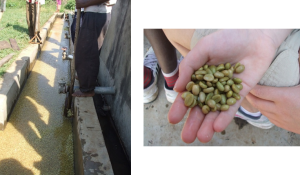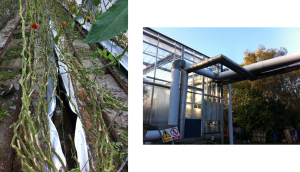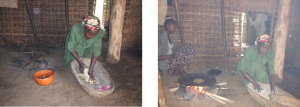Centre for Environmental Strategy Research Fellow Dr Alma López-Avilés discusses the challenges of scale with respect to research into the Water-Energy-Food Nexus:
In 2009, the UK’s previous Chief Scientific Adviser to the Government, Professor Beddington[i], talked about a ‘perfect storm’ of problems around water, energy and food shortages. He pointed out that based on a number of studies, these shortages will lead to public unrest and international conflict in the near future, unless 50% more food, 50% more energy and 30% more freshwater are available by 2030. In his speech, Prof. Beddington highlighted the need to look jointly at water, energy and food while reducing global warming and adapting to climate change impacts.
Since then, a number of projects outlining the main problems of the Nexus of Water-Energy-Food and how to tackle them are developing in the UK and elsewhere. Some of the Nexus issues have been recognised in the past, but there are underlying difficulties with Nexus studies in that Nexus issues and their interdependencies are complex, vary in scale, and mean different things for different people depending on their circumstances and geographical settings.

Water and food are linked both in subsistence agriculture and agribusinesses: washing coffee beans in Yirgalem, Ethiopia. Coffee is an important crop for the Ethiopian economy. It is vastly consumed within the country, and is also Ethiopia’s main export.
For example, in developing countries water, food and energy resources are often insufficient to meet the needs of all sectors of the population, and it is predicted that the greatest impacts of climate change will be experienced in many of these already stressed regions (e.g. sub-Saharan Africa, flood-prone mega-deltas in Asia etc.).
Thus, work on the Nexus in these geographies has to be closely linked to development and infrastructure projects where the synergies between food, energy, water, health, education, social mobility, gender equality etc. must be brought together, often in the context of rising demands.
Within developing economies two broadly differentiated Nexus scales can be seen. For example in Brazil, the Nexus can be considered at the local scale among local communities reliant on fisheries and floodplain vegetable gardens, the dry and wet season flows of Amazonian rivers, and energy (diesel) for generators and transportation brought by boat from the big cities and ports located downstream. The Nexus can also be considered at the large (broadly national) and global scales in the Amazonian basin in relation to deforestation, growing bio-fuel crops for national-scale energy generation, large-scale food production of cash crops such soya and cattle-raising for export to global markets, and using Amazonian water-courses as waterways for transportation of natural resources and hydro-electricity generation via dams.
On the other hand, in developed economies Nexus studies are more concerned with reducing the vast amounts of energy, water and food waste produced in order to reduce the environmental burdens of delivering current levels of service. Thus, Nexus projects are emerging on improving the efficiency in the use of energy and water resources in large-scale food growing and food manufacturing processes, and also on the possibility of using alternative and synergetic ways of producing energy, water and food at both large and small scales.

The Blue Nile waterfalls near Tana, Ethiopia, in the dry season. The flow of the River Abay (Blue Nile) has been diverted to generate hydro-electricity. Climate resilience and green economy policies in Ethiopia are driving the development of large hydro-dams as well as other renewable energy sources in the country, but the proliferation of hydro-dams and agribusinesses is creating some conflicts among water-users with the vast majority of them living with only limited and unreliable access to water and energy sources (see plates 4 and 5). Photos credit: A. Mulugetta-López
In energy, one focus is on finding alternatives to the conventional centralised (often national) energy generation options that may help make use of local resources and maximise resource efficiency. For example using combined heat and power plants that use wood and other biomass as fuel; producing energy from waste; and generating hydro-electricity from small flowing streams are options that help to reduce waste and green-house gas emissions. Collecting, treating and re-using water locally for example in agro-industries is another way of cutting down on water and energy consumption. Renewable energy and water efficiency schemes associated with food production are progressively being considered and implemented at large factory scale and also at the local level because these technologies can help reduce bills and negative environmental impacts while helping to generate local jobs by decentralising processes.

Tomatoes grown in hydroponics system using a nutrient-rich water solution, rather than soil, under controlled conditions of light, temperature, and humidity in a greenhouse near Gloucester, UK. An example of efficiency in agro-industrial processes, heating systems similar to the ones we have in most homes, are used to keep greenhouses warm, and CO2 generated from the combustion in boilers is fed back into greenhouses via pipes (right photograph) in order to help the crops to ripe. Photos: A. López-Avilés
When talking about the Nexus in food manufacturing, and taking the example of bread, we can consider small scale as local manufacturing (e.g. craft bread making in Oxfordshire), and large scale as national manufacturing (e.g. supermarket sliced bread in the UK). However, for both we also need to consider the global context. This is because even for local-scale low-impact food manufacturing options (e.g. artisanal/ community-based high-quality foods), and even when there is or there could be some degree of decentralisation of energy and water generation processes, these often cannot be fully detangled from global supply chains and the centralised nature of some resources.
Globalisation means that even local manufacturing processes often depend on global markets, prices and supply chains, for example for the provision of diesel as a decentralised energy source for local fishing communities in the Amazon; or for the supply of wheat for locally crafted organic bread in the UK.
Therefore, we can talk about the respective sets of problems and opportunities for the small and large scales of the Nexus in at least two broad geographical settings: developing and developed economies. However, increasingly globalised supply chains bring together the interdependencies between developed and developing economies, and so the local scale is not always (or no longer) truly ‘local’.
The issue of scale and interdependencies can get further complicated by what ‘local’ and ‘small-scale’ mean to different people (e.g. does local refer to small scale? What if it is a small manufacturing business that employs local people and uses local materials sells nationally or internationally –i.e. products are not only consumed locally-? What if a local manufacturing facility that relies on the local workforce and local consumers uses materials brought in from other countries? Is it local then?). And when talking about ‘decentralised’ food manufacturing, things can get even more convoluted because there are degrees of decentralisation.
Given the complexities around the Nexus, it seems important to clearly define the scope and scale of any Nexus study or project for the benefit of participants and communities involved. Also, it seems advisable to outline the type of interdependencies to be studied, in other words, to describe the nexuses to be considered within the Nexus.
A lot can be achieved by finding local-level improvements and solutions to Nexus problems that may be scaled-up. However, it should not be forgotten that most times there are global scale dimensions associated with food, water and energy (e.g. in the supply of raw products with their embodied water and energy). Thus, for the success of local Nexus initiatives Nexus problems have to be addressed at the global scale in all countries.
This blog can also be downloaded as a PDF document: The different scales of the Nexus_Alma Lopez-Aviles
 Dr. Alma López-Avilés is a research fellow at the Centre for Environmental Strategy, University of Surrey. Alma is working in a project funded by UK Research Councils on the Water- Energy-Food Nexus in relation to localised food manufacturing. This project, known as Local Nexus Network, is exploring among other things, the potential for decentralised energy and water supply in the UK’s food system.
Dr. Alma López-Avilés is a research fellow at the Centre for Environmental Strategy, University of Surrey. Alma is working in a project funded by UK Research Councils on the Water- Energy-Food Nexus in relation to localised food manufacturing. This project, known as Local Nexus Network, is exploring among other things, the potential for decentralised energy and water supply in the UK’s food system.
Footnotes:
[i] Beddington J. (2009) ‘Food, energy, water and the climate: a perfect storm of global events?’ In Conference presentation given to the Sustainable Development UK Annual Conference, QEII Conference Centre, London, 19 March 2009. See http://www.bis.gov.uk/assets/goscience/docs/p/perfect-storm-paper.pdf

